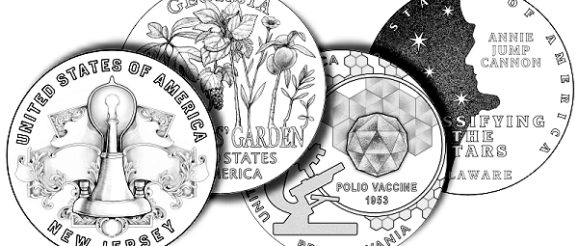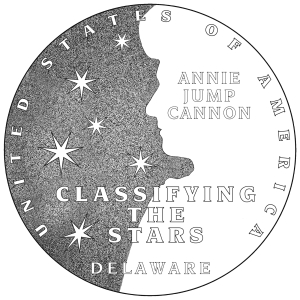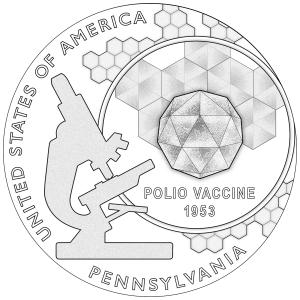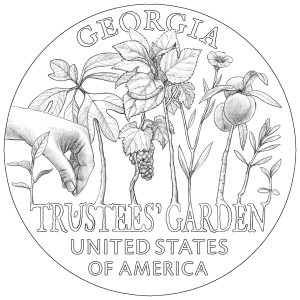Mint Unveiled 2019 American Innovation $1 Coin Program Designs

The United States Mint (Mint) unveiled the official Coin Program designs today for the. The unveiling took place at the American Numismatic Association’s World’s Fair of Money in the Donald E. Stephens Convention Center.
The $1 coins in this Coin Program feature distinctive reverse (tails) designs that pay homage to America’s ingenuity and celebrate the pioneering efforts of individuals or groups from each of the 50 states, the District of Columbia, and the United States territories. The 2019-dated coins represent innovators or innovations from Delaware, Pennsylvania, New Jersey and Georgia.
Artists in the Mint’s Artistic Infusion Program (AIP) created the designs, which were sculpted by Mint Sculptor-Engravers.
 American Innovation – Delaware
American Innovation – Delaware
Designer: Donna Weaver
Sculptor-Engraver: Joseph Menna
The Delaware $1 Coin recognizes astronomer Annie Jump Cannon who developed a system for classifying the stars that is still used today. This Coin Program design features a silhouette of Ms. Cannon against the night sky, with a number of stars visible. The inscriptions are “UNITED STATES OF AMERICA,” “ANNIE JUMP CANNON,” “CLASSIFYING THE STARS,” and “DELAWARE.”
 American Innovation – Pennsylvania
American Innovation – Pennsylvania
Designer: Richard Masters
Sculptor-Engraver: Joseph Menna
The Pennsylvania $1 Coin recognizes the creation of a vaccine to prevent polio. This Coin Program design depicts an artist’s conception of the poliovirus at three different levels of magnification along with the silhouette of a period microscope, representing the extensive research that was conducted to develop a cure for polio. The inscriptions are “UNITED STATES OF AMERICA,” “POLIO VACCINE,” “1953,” and “PENNSYLVANIA.”
 American Innovation – New Jersey
American Innovation – New Jersey
Designer: Paul C. Balan
Sculptor-Engraver: Phebe Hemphill
The New Jersey $1 Coin honors the development of a lightbulb with a filament that could last 1,200 hours. This Coin Program design features an Edison bulb against an ornate background. The inscriptions are “UNITED STATES OF AMERICA” and “NEW JERSEY.”
 American Innovation – Georgia
American Innovation – Georgia
Designer: Emily Damstra
Sculptor-Engraver: Michael Gaudioso
The Georgia $1 Coin recognizes the Trustees’ Garden, established in the 1730s. It was the first agricultural experimental garden in America. This coin’s design depicts a hand planting seeds in the inscription “TRUSTEES’ GARDEN,” from which grows a variety of species representing the variety of plants grown in the garden: an orange tree seedling, sassafras, grapes, white mulberry, flax, peaches, olive, and a young shoot too small to be identified. The additional inscriptions are “UNITED STATES OF AMERICA” and “GEORGIA.”
The common Coin Program obverse (heads side) of all the coins in this series features a dramatic representation of the Statue of Liberty and the required inscriptions “$1” and “IN GOD WE TRUST.”
The Mint will release coins featuring these Coin Programdesigns later this year.
The American Innovation™ $1 Coin Program is authorized by Public Law 115-197—the American Innovation $1 Coin Act of 2018 (Act). The Act directs the Mint to strike and issue non-circulating $1 coins in recognition of significant innovations and pioneering efforts of individuals or groups from each of the 50 States, the District of Columbia, and the United States territories—Puerto Rico, Guam, American Samoa, the U.S. Virgin Islands, and the Commonwealth of the Northern Mariana Islands. The Mint will issue these coins at a rate of four per year in the order each State ratified the Constitution of the United States or was admitted into the Union. The program began in 2018 and will span a 14-year period.
About the United States Mint
Congress created the United States Mint in 1792, and the Mint became part of the Department of the Treasury in 1873. As the Nation’s sole manufacturer of legal tender coinage, the Mint is responsible for producing circulating coinage for the Nation to conduct its trade and commerce. The Mint also produces numismatic products, including proof, uncirculated, and commemorative coins; Congressional Gold Medals; silver and bronze medals; and silver and gold bullion coins. Its numismatic programs are self-sustaining and operate at no cost to taxpayers.
